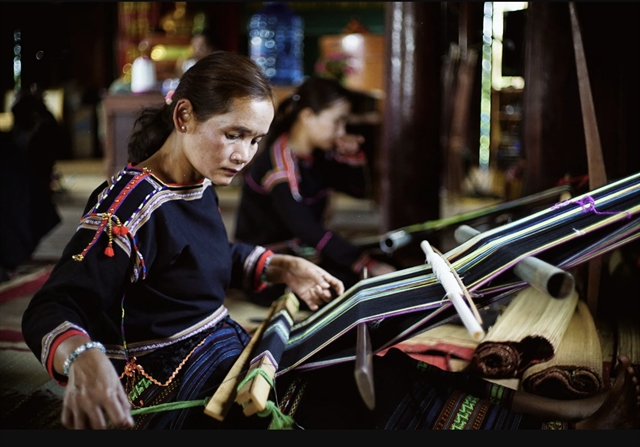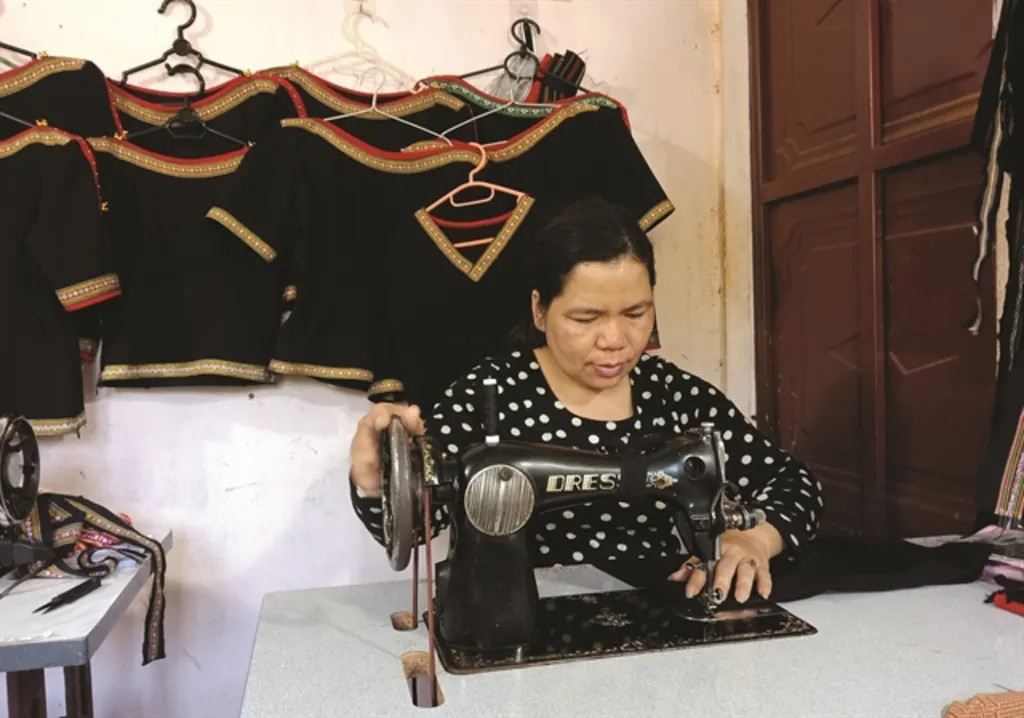 |
| H'Hen Niê wearing a traditional Ê Đê costume in her final walk in Miss Universe Việt Nam 2018. Photo Miss Universe Việt Nam |
The heart of Ê Đê culture beats with the rhythmic threads of their unique handloom weaving. Beyond a mere fabric, it acts as a symbol of cultural identity for the Ê Đê ethnic minority.
Việt Nam boasts a rich tapestry of diverse ethnic groups. Among these is the Ê Đê, the 12th largest out of 54 in the country, with a population of over 331,000 residing mainly in the provinces of Đắk Lắk, Gia Lai, Khánh Hoà, and Phú Yên.
Ê Đê women meticulously weave cloth on handlooms. The resulting fabric serves various purposes, from everyday blankets and skirts to precious dowries for weddings or offerings for the deceased.
Ê Đê handloom weaving begins with cotton. After harvesting, it undergoes a meticulous process of beating, spinning and dyeing, with natural sources like mud, leaves, tubers, roots, and forest bark being used to create colours.
Traditionally, the palette was simple, including the two main colours black and red. Over time, the range expanded to include five colours: red, black, yellow, blue, and white.
To achieve these colours, the Ê Đê used to rely completely on natural sources. For example, black tones owe their richness to crushed and cooked tree bark, while vibrant yellow comes from turmeric.
They usually use dark backgrounds, either black or dark indigo, representing their desire to harmonise with nature.
 |
| Handloom fabric carries with it the heritage and traditions of the ethnic Ê Đê people, resonating as a symbol of identity for them. Photo daidoanket.vn |
The patterns on the Ê Đê handloom fabric showcase stylised geometric forms of trees, flowers, leaves, birds, and other animals, along with straight, zigzag, curved, and broken lines. These patterns often denote gender, occasion, status, or prosperity.
Decline in tradition
Traditionally, in the Ê Đê community, girls were taught by their grandmothers and mothers how to weave from the ages of 12 or 13. But that tradition is fading away.
“My great-grandmother knew how to weave cloth. However, in my generation, the craft of handloom weaving has faded. Me and my sister didn’t have the opportunity to learn,” said H’Dậu Êban, a 23-year-old Ê Đê woman in Buôn Ma Thuột City.
Amí Loan, a resident of Akô Dhông Village, also in Buôn Ma Thuột, reminisced about a time when women in her village all wove fabric on handlooms. Today, their looms stand silent. Out of 67 Ê Đê households in the village, only four or five continue to do weaving, mostly by the elderly.
This decline is not unique to the village. Y Hồng, chief of Buôn Lác Village in Khánh Hoà, also spoke about the loss of traditional crafts in his community. Once a village bustling with over half of its population engaged in handloom weaving, now there is only one artisan.
The labour-intensive nature of handloom weaving combined with its low profitability has deterred young people from pursuing the craft. Jobs such as sugarcane harvesting offer quicker and more attractive returns.
“If this situation continues, the traditional craft of Ê Đê weaving will face extinction, leaving no one to cherish or mourn its loss,” said H’Ler Êban, chairman of the Việt Nam Fatherland Front Committee of Buôn Ma Thuột City.
Glimmer of hope
However, amid these challenges, a ray of hope shines through. Collective efforts have been made to rekindle the ancient craft of Ê Đê handloom weaving.
“Artisans spend weeks weaving traditional fabric, but finding buyers is tough,” H’Ler Êban, a local dressmaker, said. “It discourages the weavers to continue.”
To change this, H’Ler opened Amí Sia, a dressmaker's shop with the aim of not only preserving traditional cloth weaving but also infusing modern innovation. Collaborating with local weavers, she creates costumes by combining ribbed spandex with their handloom fabric.
 |
| H'ler Êban, owner of Amí Sia dressmaker's shop, often spends time to design costumes using handloom fabric bought from local artisans. Photo courtesy of H'ler Êban |
The outcome is remarkable. “My shop sells hundreds of pieces of ethnic costumes annually,” H’Ler said.
“I’m happy that I was able to help encourage several artisans to continue with handloom weaving and provide them with stable incomes.”
Similar to H’Ler’s vision, the women’s organisation in Suối Trai Commune, Sơn Hoà District, Phú Yên, has set up a handloom weaving club.
“The club was established to foster learning and doing handloom weaving in the commune. It helps nurture the love for the weaving tradition and strengthens the preservation process,” said Sô Đa, chairman of the People's Committee of Suối Trai Commune.
Beyond the village borders, costumes and designs using ethnic patterns have been showcased on the international stage.
H’Hen Niê, Miss Universe Việt Nam 2017 and Top 5 Miss Universe 2018, is an Ê Đê ethnic. Born and raised in Đắk Lắk, H’Hen has always been immersed in the rich culture of the Ê Đê.
 |
| H'Hen Niê often wears traditional Ê Đê costumes or áo dài (Vietnamese national long dress) with ethnic patterns in multiple local and international events, Photo courtesy of H'Hen Niê |
After being crowned in 2017, she has been seen wearing her traditional Ê Đê costumes and áo dài (Vietnamese national long dress) with ethnic patterns in multiple local and international events, including during the Miss Universe 2018 in Thailand.
Images of her wearing áo dài with ethnic patterns have received positive reactions worldwide.
“The patterns on her áo dài are stunning,” said a comment under a post of H’Hen wearing áo dài with ethnic patterns on Vogue Thailand’s Instagram account.
H’Hen said that her traditional Ê Đê costumes and fabric patterns on her áo dài were woven by artisans in her hometown, and whenever she wears them, she thinks about the effort and time spent making them.
“Wearing ethnic costumes is not only a way to promote the costumes themselves but also a way to express my gratitude to the artisans who tirelessly work day and night by the loom,” said H’Hen.
“I hope that both Vietnamese and foreigners will come to love dresses made of handloom fabric as I have, and that others can be inspired to create new designs.”
Some designers have embraced cloth with ethnic patterns. Among them is Trung Beret (Nguyễn Thành Trung). As a native of the Central Highlands, Trung drew inspiration from the Ê Đê handloom fabric patterns for his own designs.
 |
| As a native of Central Highlands, Trung Beret drew inspiration from the Ê Đê and other ethnic minorities' fabric patterns for his own unique designs. Photo courtesy of Trung Beret |
Trung is determined to use handloom cloth in his design instead of printed or embroidered materials, despite the rough nature of the traditional cloth making it challenging to use in modern designs.
His choice to incorporate handloom fabric into his designs stems from its profound cultural value and his hope to bring it closer to international audiences.
Trung also shared his plan to showcase Vietnamese handloom fabric on the global stage by participating in the International Fashion Week scheduled in Thailand and the Philippines in November and December.
“I want to bring handloom fabric products that can appear more approachable and appealing to international customers while preserving the essence of Vietnamese ethnic culture,” Trung said.
Lưu Vũ, the founder of Ê Đê Yarns, treads a different path with the same goal – preserving the Ê Đê ancient craft.
 |
| A member of Ede Yarns using a tool to remove seeds from cotton fibres. Photo courtesy of Lưu Vũ |
“A society cannot have its own distinctive colour while developing without native knowledge,” Vũ said.
This concern has inspired Vũ and a group of young people to form Ê Đê Yarns, a project to restore the most authentic Ê Đê handloom weaving. Their journey was not without challenges.
“In Đắk Lắk, original Ê Đê handloom weaving has not been practised for over 40 years,” Vũ said. “Many key stages in the process of weaving haven’t been properly recorded, making it hard to restore truly original fabric.”
Vũ and his team sought expertise from cultural collectors, local artisans, and fabric weavers in other cities such as Nghệ An or Hà Nội and joined garment-making courses.
 |
| A member of Ede Yarns is learning how to spin thread from a local artisan. The group is determined to restore the craft of Ê Đê handloom weaving. Photo courtesy of Lưu Vũ |
One by one, the team restored each phase in the process, from making a traditional loom to finding and using indigenous plants for making yarns and for dyeing.
“I could never forget the surprised expression and the tearful eyes of an old artisan after hearing the creaking sound from the loom we rebuilt,” Vũ said. “She said it had been years since she heard the familiar sound.”
Moments like this encourage Ê Đê Yarns members to continue their journey. Going forward, the team aims to refine their knowledge related to traditional handloom weaving.
These efforts hold the potential for lasting benefits, not only for preserving handloom weaving, but also for developing the culture of ethnic minorities.
In recent years, many foreign tourists have been drawn to the Central Highlands region, alongside popular destinations in coastal cities, to delve into the ethnic cultures.
 |
| More and more foreign tourists, captivated by the beauty of ethnic cultures, are choosing the Central Highland provinces as the destinations for their vacation in Việt Nam. Photo dantocmiennui.vn |
"I really enjoyed my visit to Central Highlands,” said Lee Jeong-min, a Korean tourist. “Việt Nam offers more than just picturesque beaches. The striking handloom fabric patterns that adorn the mountains and forests of the region are truly captivating."
According to Thái Hồng Hà, director of Đắk Lắk's Department of Culture, Sports, and Tourism, their strategy to 2030 involves leveraging resources to preserve and promote ethnic cultures.
The plan includes establishing cultural institutions and nurturing community-based tourism in minority villages to enhance and protect their traditional cultures.
Boosting conservation initiatives and incorporating handloom weaving into visiting tours will highlight Ê Đê craftsmanship, and ethnic diversity while improving local economies. VNS